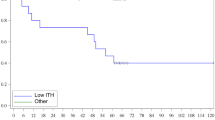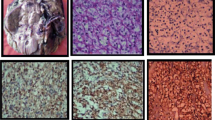Abstract
Heterogeneity is an inherent event to tumour development that is lately receiving much attention in oncologic research. The topic is being addressed primarily at the molecular level, and results are promising. However, translation to practical medicine is still pending. Our intention in this study is to approach the problem in a series of clear cell renal cell carcinomas with the tools that pathologists use in routine practice. Three randomly selected areas of 48 clear cell renal cell carcinomas prospectively collected in two different institutions were analysed for intratumour heterogeneity. The evaluated parameters were tumour size, cell type (clear vs. eosinophilic), Fuhrman’s grade and immunohistochemical expression of carbonic anhydrase IX, BRCA1-associated protein-1 (BAP-1), cyclooxygenase-2 (COX-2) and Ki67. Intratumour heterogeneity was detected in 26 cases (54 %). Cell type, grade and Ki67 index were the parameters more frequently heterogeneous amounting, respectively, 44, 42 and 38 %. Tumour size was a significantly discriminative factor to predict tumour heterogeneity, with a cut-off of 3.8 cm (p < 0.001). Aside from tumour size, the most relevant parameters related with intratumour heterogeneity were cell type (clear vs. eosinophilic), Fuhrman’s grade and Ki67 and COX-2 expression patterns. Carbonic anhydrase 9 and BAP-1 did not show statistical relevance. We conclude that heterogeneity is a common event in clear cell renal cell carcinomas that may be overlooked in cases insufficiently sampled. Tumour size appears as a reliable tool in identifying this situation since clear cell renal cell carcinomas under 3.8 cm in diameter are always homogeneous. This point may help the pathologist to make decisions in tumour sampling.



Similar content being viewed by others
References
Souza DL, Bernal MM (2012) Incidence, prevalence and mortality of kidney cancer in Spain: estimates and projections for the 1998–2022 period. Actas Urol Esp 36:521–526
Siegel R, Naishadham D, Jemal A (2013) Cancer statistics, 2013. CA Cancer J Clin 63:11–30
Tunuguntla HSGR, Jorda M (2008) Diagnostic and prognostic molecular markers in renal cell carcinoma. J Urol 179:2096–2102
Moch H (2012) Renal cancer biomarkers. What is justified? Pathologe 33(Suppl 2):278–281
Craven RA, Vasudev NS, Banks RE (2013) Proteomics and the search for biomarkers for renal cancer. Clin Biochem 46:456–465
De la Fuente IM, Cortés JM, Pelta DA, Veguillas J (2013) Attractor metabolic networks. PLoS One 8:e58284
De la Fuente IM (2013) Metabolic dissipative structures. In: Systems biology of metabolic and signaling Networks: energy, mass and information transfer. In: Aon MA, Saks V, Schlattner U (eds) Springer Series in Biophysics 16. Springer, New York, pp 179–212
Cancer Genome Atlas Research Network (2013) Comprehensive molecular characterization of clear cell renal cell carcinoma. Nature 499:43–49
Shibata D (2012) Heterogeneity and tumor history. Science 336:304–305
Navin N, Hicks J (2011) Future medical applications of single-cell sequencing in cancer. Genome Med 3:31
López JI (2013) Renal tumors with clear cells. A review. Pathol Res Pract 209:137–146
Serrano MF, Katz M, Yan Y, Kibel AS, Humphrey PA (2008) Percentage of high-grade carcinoma as a prognostic indicator in patients with renal cell carcinoma. Cancer 113:477–483
López JI, Guarch R, Camarasa N, Caceres M, Moreno V, Muñiz G, García-Prats MD, Orozco R (2012) Grade heterogeneity in clear cell renal cell carcinoma. BJU Int. doi:10.1002/BJUIw-2012-091-web
López JI, Guarch R, Larrinaga G, Corominas-Cishek A, Orozco R (2013) Cell heterogeneity in clear cell renal cell carcinoma. APMIS 121:1187–1191
Krill-Burger JM, Lyons MA, Kelly L, Sciulli CM, Petrosko P, Chandran UR, Kubal MD, Bastacki SI, Parwni AV, Dhir R, LaFramboise WA (2012) Renal cell neoplasms contain shared tumor type-specific copy number variations. Am J Pathol 180:2427–2439
Algaba F, Delahunt B, Berney DM, Camparo P, Comperat E, Griffiths D, Kristiansen G, Lopez-Beltran A, Martignoni G, Moch H, Montironi R, Varma M, Egevad L (2012) Handling and reporting of nephrectomy specimens for adult renal tumours: a survey by the European network of uropathology. J Clin Pathol 65:106–113
Arai E, Kanai Y (2010) Genetic and epigenetic alterations during renal carcinogenesis. Int J Clin Exp Pathol 4:58–73
Edge SB (2010) AJCC cancer staging handbook, 7th edn. Springer, New York
Fuhrman SA, Lasky LC, Limas C (1982) Prognostic significance of morphologic parameters in renal cell carcinoma. Am J Surg Pathol 6:655–663
Hall M, Frank E, Holmes G, Pfahringer B, Reutemann P, Witten IH (2009) The WEKA data mining software: an update. SIGKDD Explorations 2009; The WEKA data mining software: an update; SIGKDD Explorations; 11: 10–18
Breiman L, Friedman JH, Olshen RA, Stone CJ (1984). Classification and regression trees. Chapman and Hall/CRC.
Nowell PC (1976) The clonal evolution of tumor cell populations. Science 194:23–28
Gerlinger MM, Rowan AJA, Horswell SS, Larkin J, Endesfelder D, Gronroos E, Martinez P, Matthews N, Stewart A, Tarpey P, Varela I, Phillimore B, Bequm S, McDonald NQ, Butler A, Jones D, Raine K, Latimer C, Santos CR, Nohadani M, Eklund AC, Spencer-Dene B, Clark G, Pickering L, Stamp G, Gore M, Szallasi Z, Downward J, Futreal PA, Swanton C (2012) Intratumor heterogeneity and branched evolution revealed by multiregion sequencing. N Eng J Med 366:883–892
Crockford A, Jamal-Hanjani M, Hicks J, Swanton C (2014) Implications of intratumour heterogeneity for treatment stratification. J Pathol 232:264–273
Williamson SR, Kum JB, Goheen MP, Cheng L, Grignon DJ, Idrees MT (2014) Clear cell renal cell carcinoma with a syncytial-type multinucleated giant tumor cell component: implications for differential diagnosis. Hum Pathol. doi:10.1016/j.humpath.2013.10.033
Chapman-Fredriks JR, Herrera L, Bracho J, Gomez-Fernandez C, Leveillee R, Rey L, Jorda M (2011) Adult renal cell carcinoma with rhabdoid morphology represents a neoplastic dedifferentiation analogous to sarcomatoid carcinoma. Ann Diagn Pathol 15:333–337
Nassar A, Radhakrishnan A, Cabrero IA, Cotsonis GA, Cohen C (2010) Intratumoral heterogeneity of immunohistochemical marker expression in breast carcinoma. A tissue microarray-based study. Appl Immunohistochem Mol Morphol 18:433–441
Fiaschi T, Giannoni E, Taddei ML, Cirri P, Marini A, Pintus G, Nativi C, Richichi B, Scozzafava A, Carta F, Torre E, Supuran CT, Chiarugi P (2013) Carbonic anhydrase IX from cancer-associated fibroblasts drives epithelial-mesenchymal transition in prostate carcinoma cells. Cell Cycle 12:1791–1801
Bui MHT, Seligson D, Han KR, Pantuck AJ, Dorey FJ, Huang Y, Horvath S, Liebovich BC, Chopra S, Liao SY, Stanbridge E, Leman MI, Palotie A, Figlin RA, Belldegrun AS (2003) Carbonic anhydrase IX is an independent predictor of survival in advanced renal cell clear cell carcinoma: implications for prognosis and therapy. Clin Cancer Res 9:802–811
Zhang BY, Thampson RH, Lohse CM, Dronca RS, Cheville JC, Kwon ED, Liebovich BC (2013) Carbonic anhydrase IX (CAIX) is not an independent predictor of outcome in patients with clear cell renal cell carcinoma (ccRCC) after long-term follow-up. BJU Int 111:1046–1053
Stillebroer AB, Mulders PFA, Boerman OC, Oyen WJ, Oosterwijk E (2010) Carbonic anhydrase IX in renal cell carcinoma: implications for prognosis, diagnosis, and therapy. Eur Urol 58:75–83
Murali R, Wiesner T, Scolyer RA (2013) Tumours associated with BAP1 mutations. Pathology 45:116–126
Jensen DE, Rauscher FJ 3rd (1999) BAP1, a candidate tumor suppressor protein that interacts with BRCA1. Ann N Y Acad Sci 886:191–194
Duns G, Hofstra RM, Sietzema JG, Hollema H, van Duivenbode I, Kuik A, Giezen C, Jan O, Bergsma JJ, Bijnen H, van der Vlies P, van der Berg E, Kok K (2012) Targeted exome sequencing in clear cell renal cell carcinoma tumors suggests aberrant chromatin regulation as a crucial step in ccRCC development. Hum Mutat 33:1059–1062
Pena-Llopis S, Vega-Rubin-de-Celis S, Liao A, Leng N, Pavía-Jiménez A, Wang S, Yamasaki T, Zhrebker L, Sivanand S, Spence P, Kinch L, Hambuch T, Jain S, Lotan Y, Margulis V, Sagalowsky AI, Summerour PB, Kabbani W, Wong SW, Grishin N, Laurent M, Xie XJ, Haudenschild CD, Ross MT, Bentley DR, Kapur P, Brugarolas J (2012) BAP1 loss defines a new class of renal cell carcinoma. Nat Genet 44:751–759
Ghosh N, Chaki R, Mandal V, Mandal SC (2010) COX-2 as a target for cancer chemotherapy. Pharmacol Rep 62:233–244
Wang X, Zhang L, O’Neill A, Bahamon B, Alsop DC, Mier JW, Goldberg SN, Signoretti S, Atkins MB, Wood CG, Bhatt RS (2013) Cox-2 inhibition enhances the activity of sunitinib in human renal cell carcinoma xenografts. Br J Cancer 108:319–326
Bui MHT, Visapaa H, Seligson D, Kim H, Han KR, Huang Y, Horvath S, Stanbridge EJ, Palotie A, Figlin RA, Belldegrun AS (2004) Prognostic value of carbonic anhydrase IX and Ki67 as predictors of survival for renal clear cell carcinoma. J Urol 171:2461–2466
Acknowledgments
The authors thank Ana Abascal, Mar González, Aida Larrañaga and Alicia Esteve for their excellent laboratory assistance.
Conflict of interest
The authors declare that they have no conflict of interest.
Author information
Authors and Affiliations
Corresponding author
Rights and permissions
About this article
Cite this article
Zaldumbide, L., Erramuzpe, A., Guarch, R. et al. Large (>3.8 cm) clear cell renal cell carcinomas are morphologically and immunohistochemically heterogeneous. Virchows Arch 466, 61–66 (2015). https://doi.org/10.1007/s00428-014-1673-8
Received:
Revised:
Accepted:
Published:
Issue Date:
DOI: https://doi.org/10.1007/s00428-014-1673-8




